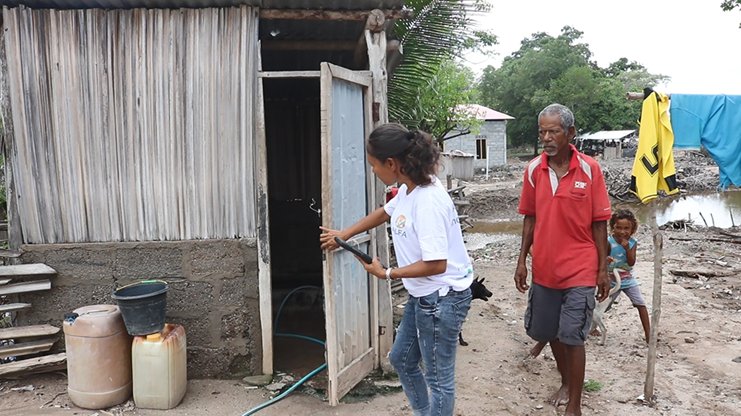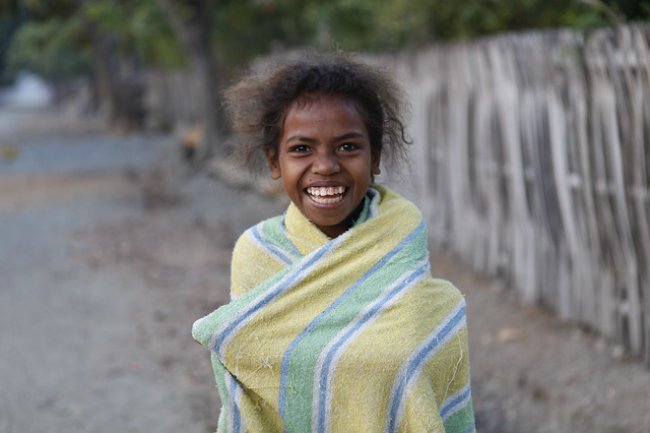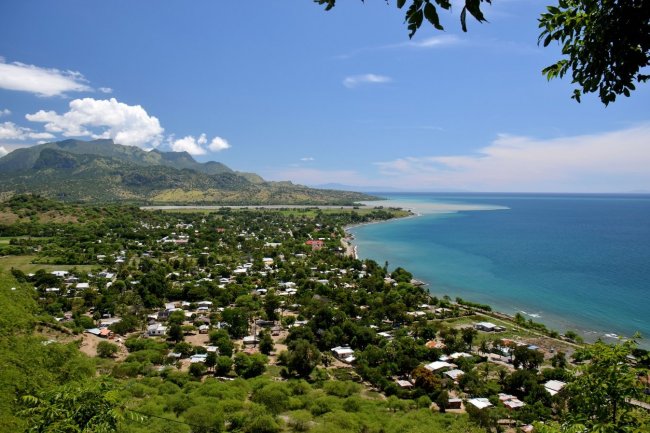Community-Led Total Sanitation : Timor Leste (East Timor)
The JMP estimate suggests improved sanitation coverage in rural areas at 27 per cent in 2015. While this appears to be a decline since 2000 it is more of an adjustment between the proportion of improved and unimproved facilities during this period. Importantly, open defecation rates have fallen by a third, from 55-36 per cent in 2015.

CLTS status and geographic spread
The Community-Led Total Sanitation (CLTS) approach to sanitation improvement was introduced by WaterAid to Timor-Leste in 2007 and has now been established as the lead approach to sanitation in Timor-Leste. In 2012 the National Basic Sanitation Policy was adopted which establishes the Ministry of Health as the lead national agency for rural sanitation and promulgates that demand-lead approaches, in particular CLTS, lead the implementation of Rural Sanitation with technical guidance from the Ministry of Public Works. CLTS is encapsulated within the Ministry of Health’s national approach to improving sanitation and hygiene practice, Community Action Planning for Sanitation and Hygiene (PAKSI).
CLTS has spread to all 13 districts in Timor-Leste (100 per cent geographical spread), and to approximately 80-128 sucos (villages) out of 401 rural sucos (20-30 per cent). Since 2012 there has been a consolidation of local NGOs implementing CLTS with both local and international NGOs leaving the sector. UNICEF is implementing in six districts, the DFAT BESIK programme is in one district (Bobonaro), Plan International and WaterAid are implementing in two districts each, while World Vision is working in three districts, and ADRA has limited presence in two sub-districts in the Viqueque district. BESIK supports the secretariat for coordination of the Bobonaro district ODF plan, which is the only district to have a district-wide plan for achieving ODF. In Bobonaro out of five administrative posts (50 sucos) BESIK is taking care of three administrative posts (25 sucos), UNICEF one administrative post (18 sucos) and World Vision one administrative post (seven sucos). BESIK and UNICEF also provide support to the MoH to coordinate CLTS nationwide. The MoH stopped implementing in early 2015.
CLTS is being implemented in semi-urban settings such as district and sub-district headquarters but not in major urban areas such as the capital city Dili.
Of some concern is that a small number of government agencies and civil society organisations are still implementing direct up-front hardware subsidy approaches.
CLTS variations and practice
PAKSI BESIK has supported the MoH in delivering a PAKSI programme that includes hand washing with soap, with a major HWWS campaign in 2012-2013. PAKSI (Participatory Community Action to Sanitation and Hygiene – In Tetun language) is a localized version of CLTS. PAKSI evolved in 2012 from the lessons of the early CLTS experiences in Timor-Leste; the phased sanitation approach in the National Basic Sanitation Policy; the success of the DNSA community action planning (CAP) approach to water supply development; and the decision that the MoH district offices should lead the process. The PAKSI approach is a participatory process for community-based ignition, planning and action to stop open defecation and wash hands with soap. PAKSI includes a form of CLTS modified to suit Timorese conditions and cultural sensitivities, notably by focusing on disgust rather than shame as the main trigger for behaviour change, and is a structured approach designed to be easier for field
workers and communities to understand and support.
Schools WASH: CLTS is integrated with WASH in schools.
Nutrition: UNICEF/World Food Programme/MoH are leading an EU-funded nutrition project in three districts. UNICEF is implementing CLTS in all three districts (together with BESIK and World Vision in Bobonaro; alone in Ermera and together with Plan in Ainaro) and leading the integration of nutrition and CLTS. Partners are currently working out how to develop comprehensive behaviour change messages that include WASH and nutrition and are properly sequenced. DFAT may also trial an
integrated nutrition and WASH approach in Manufahi. In Timor-Leste, where there is severe child malnutrition, sanitation partners are interested in integrating the two disciplines in a more systematic way and sanitarians and nutritionists using the same language.
Institutional triggering
In 2015 in Bobonaro district Kamal Kar facilitated an institutional triggering that succeeded in engaging the District Administrator to take the lead around engaging local government (Administrative Post, Suco, and Aldeia) in mobilizing communities to participate in PAKSI. A road map for ODF Bobonaro has been developed under the leadership of the administrator and BESIK; UNICEF and World Vision are supporting the plan on the ground.
CLTS scale and ODF success rate
From current data sources (SIBS water and sanitation information system, and SPT Sector Planning Tool) it is difficult to calculate the number of CLTS triggered communities (aldeia), but it is thought to be more than 1,000. Implementing partners in Timor-Leste estimate that 602 communities are ODF. Reaching ODF takes a community between two months and one year, with UNICEF reporting 4-9 months. Indications are that CLTS is having a significant impact on sanitation access and also sustainability of ODF behaviour. An end-line survey of 55 communities (5,000 families) conducted by UNICEF in December 2014 found a slippage rate of 27 per cent (3-42 per cent reversion). 60 per cent these ODF aldeias (33 no.) had less than a 10 per cent reversion two to three years after ODF declaration. There had been a substantial decrease of open defecation by communities in project target areas and moderate improvement building permanent latrines to move up the sanitation ladder. All sucos of four sub-districts (two each from Aileu and Ermera) were verified and declared ODF but there is a reversion of 3-10 per cent. Overall open defecation was reduced from 73 per cent to 9 per cent (Liquidoe, Aileu District) and 88 per cent to 3 per cent (Railaco, Emera Disrict). In Alieu district CLTS has been the dominant approach in the municipality since 2010. In 2009, the sanitation coverage rate for the district was estimated to be 20 per cent, in 2015, the estimated coverage is at least 85 per cent, even with slippage taken into account.
Successful triggers include: disgust; privacy, convenience, desire for good health and the stigma of continuing open defecation. BESIK has found some success in triggering around adopting using a toilet as a new social norm where institutional triggering has been done i.e. Bobonaro.
CLTS capacity
Approximately 200 CLTS facilitators have been trained to date, including 65 who were trained by Kamal Kar in 2015 and of whom 15 were invited back to a more in-depth training in May 2015 to establish a PAKSI Quality Control/Support Team for PAKSI implementers in Bobonaro. Of all the trained facilitators nationwide, about 55 facilitators are still active, including 15 in WaterAid and 20 in UNICEF and five with Plan and its local NGO partners. Attrition is often due to NGO staff moving to a new unrelated job. A core group of 10-15 ‘super trainers’ exists, who are highly competent trainers and CLTS facilitators.
Most significant changes since 2012
- New types of triggering: Institutional triggering has been introduced to motivate district authorities and to increase awareness on sanitation issues. In Bobonaro this is showing positive signs. Separate triggering sessions with children have been tried and are showing influence on parents.
- Improved facilitation skills: Facilitator skills have been improved through training, particularly focusing on pre and post triggering. Five batches of trainings to improve facilitations skills involving 200 facilitators have been held, with three of these trainings facilitated by Dr. Kamal Kar and his associates from CLTS Foundation.
- Improved coordination: Improved coordination among CLTS implementing agencies. This has been achieved through implementation of five joint training of facilitators. Partners are also doing joint planning for achieving ODF in Bobonaro district, and this process has potential to be expanded to other districts.
- Greater acceptance of CLTS: CLTS (PAKSI) is gaining acceptance and popularity among the district authorities and communities; e.g. communities and authorities have started using the term “tae” (meaning ‘faeces’ in the local language).
Lessons learned
Government leadership is needed to scale up: CLTS is still INGO and UNICEF-led, and government, especially MoH, is highly dependent on donors. Without Government’s strong commitments, especially from the decision makers, it will be difficult to expand CLTS nationwide. There is a need for government to allocate dedicated budget for monitoring and follow-up of CLTS activities with adequate human resources in the Environmental Health Department (EHD) of MoH. Without a strong, committed and equipped EHD, CLTS cannot be led effectively by EHD.
Subsidies undermine CLTS: Household subsidy is still practised by CVTL which works in many communities across number of districts and undermines CLTS to some extent. The modality of subsidy by CVTL needs to be changed (it could be an incentive to move up the sanitation ladder after ODF).
Sector actors need common understandings and goals: There is no comprehensive common understanding or analysis of the rural sanitation sector yet and no common path forward. Implementing partners see parts of the problems and solutions but there is a need for everyone to join hands to remove the bottleneck and barriers in a synchronized manner. There is no costed strategy (or action plan/road map) for sanitation with a clear target of ODF for Timor-Leste by a target date. Agencies and partners are still talking about sanitation for all by 2030 (as per Government’s Strategic Plan 2011-2030), however this target is very ambiguous and farsighted. An interim target of ODF Timor-Leste is needed much earlier than 2030 to drive action and resource allocation. All partners need to use the same approach.
Pre-triggering of government institutions can unlock doors: More effort is needed on institutional triggering as this has been neglected in the past. By engaging municipal administrators this connects through line responsibility down to suco chiefs and is a way of opening doors to lower levels of government. More work is needed on identifying and accessing the entry points to local government (sub-district and suco level) decision-making meetings and how CLTS can be introduced at the pre-triggering phase. From Bobonaro it was found that working with suco councils rather than just suco chiefs gives access to two women’s representatives and a youth representative who can support sanitation in their communities more effectively than just relying on aldeia chiefs.
CLTS weaknesses and bottlenecks
- Capacity of facilitators: Lack of skilled and committed facilitators is still a major problem.
- Few CLTS implementers: Lack of partners due to funding uncertainty for CLTS activities. Only few international agencies (e.g. UNICEF, Plan and WaterAid) are committing to expanding CLTS in their project districts. There is no firm commitment from Government to fill the coverage gap (no funds set aside from Government for scaling-up CLTS activities).
- Weak monitoring: Limited monitoring from the Government for CLTS activities implemented by international agencies (INGOS, UNICEF etc.). Lack of follow-up plan after ODF for supporting communities to sustain the behaviour. No overall reliable database for assessing progress and sustainability. There is a need to take stock of what has been achieved in districts since the start of CLTS to learn from successes and failures, and improve SIBS so that it can be better used as a tool for monitoring.
- Mindset on subsidies: Some of the key DNSA staff (and other Government e.g. ministers/vice ministers) see CLTS toilets as inferior and that subsidies are needed with sanitation marketing. A change in mindset of government as well as some implementers is needed.
- Lack of integrated approach: There is no integrated approach with all the elements in place needed to make CLTS work – e.g., strategy and targets, product availability, institutional buy-in, and Behaviour Change Communications. The enabling environment is not in place and no analysis has been done on what is required e.g. bottleneck analysis.
- Weak information: The sector is lacking in joint analysis, reflection, and problem solving on CLTS. A common understanding of barriers and the way forward does not exist. The known enablers are not identified – why have some aldeias become ODF and stayed that way? The learning of successes is not being captured.
CLTS opportunities over the next 3-5 years
- Integrating CLTS and nutrition: Timor-Leste has the highest under five stunting rate (50.2 per cent). The Government of Timor-Leste and some funding agencies (e.g. EU) are working together to improve its nutrition status. There is a window of opportunity to advocate a link between malnutrition, poor sanitation and hygiene (especially open defecation) and garner support for sanitation (CLTS) as a pre-requisite for improving the nutrition status among children. Donor agencies are doing this but have not been able to convince the Government to allocate funds for sanitation yet. There is a need for additional work in this area.
- Institutional structure: Supportive institutional set-up. Government structures run all the way down to the aldeia level, with each level having an elected representative. If the national authority gives adequate support and direction, expanding CLTS should not be a major problem.
- Small size of country: Timor-Leste is a small country, and all villages are accessible within a few hours travel from the district headquarters. This has advantages for the spread of information and materials which needs to be capitalized on.


